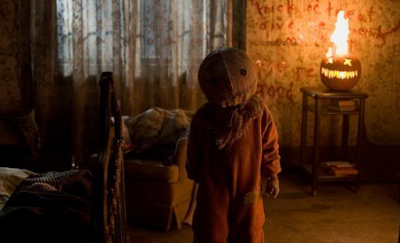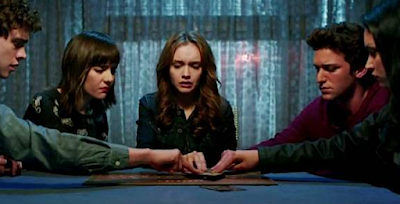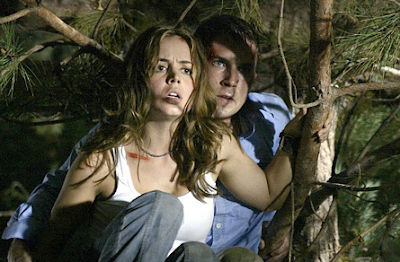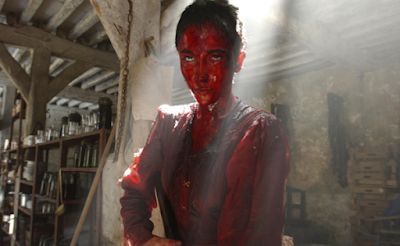(dir. J.J. Abrams)
 |
| Walt Disney Studios Motion Pictures |
“It's true. All of it. The Dark Side, the Jedi.
They're real.”
*Minor plot spoilers ahead.
In a few short years (well, long years for the most
eager fans) Star Wars Episode VII
went from being an impossibility to perhaps the most anticipated movie of all
time. J.J. Abrams went from definitely not directing, to having the weight of a
galaxy on his shoulders. From a behind the scenes angle, the Star Wars franchise has always been seen
as a bit of a gamble, an improbability not always in terms of financial
success, but quality. The question was never whether or not Disney, the
reformatted Lucasfilm, and J.J. Abrams could bring in the money, but whether The Force Awakens could simultaneously
live up to the nostalgia of the Original Trilogy, work through the middling
response to the Prequels without ignoring them, attract new and old audiences,
and serve as a pleasing launchpad for Hollywood’s newest franchise model: the
cinematic universe. Of course, none of these aspects would be small
achievements by themselves, and to achieve them all would seemingly need
nothing short of a large-scale revolution of Hollywood’s blockbuster practices.
But J.J.Abrams understood that a massive upheaval of the mythology was not what
was needed for this first new installment, and instead returned to what had
first electrified audiences in 1977 while implementing changes in other areas
of necessity.
Set 30 years after Return
of the Jedi (1983), The Force Awakens
ushers us into a world where the remnants of the Galactic Empire have formed
The First Order, a massively powered terrorist group backed by mysterious dark
side forces. Pit against them is the Resistance, a reformed Rebel Alliance,
secretly supported by the New Republic. At the center of their conflict is a
map that leads to the missing Luke Skywalker, the last Jedi, whose reappearance
or death could turn the tides for either side in the brewing war. But fear not,
politics and galactic schemes take a back seat to the introduction of new characters
and familiar faces. Swept up into the Resistance’s battle are Rey (Daisy
Ridley), a scavenger with a mysterious past, and Finn (John Boyega), a
Stormtrooper who has broken free of his conditioning and abandoned his post.
With the aid of two familiar smugglers, Han and Chewie, and the droid BB-8, who
contains part of a map leading to Luke Skywalker, Rey and Finn are swept up in an
adventure that changes the fate of the galaxy.
As the film moves along with an ease that buries any
notice of the 135 minute runtime, it’s hard not to become increasingly aware of
the similarities The Force Awakens
shares with A New Hope. While some
may feel disappointed that the film doesn’t attempt to break new narrative grounds,
the similarities work in terms of making Star
Wars feel like Star Wars. As odd
as it may seem, many of us have forgotten what seeing Star Wars for the first time actually feels like. The prequels
crafted an almost entirely different world and scale (one that fit with Lucas’ sensibilities), and the franchise’s progeny, as entertaining and occasionally
fantastic as some of those have been, haven’t fully captured what makes Star Wars so exciting. There really is
no replacing the feeling, grandeur, characters, or sense of mystery that comes
along with that galaxy far, far away.
The familiar story beats in The Force Awakens ground the film in its singular identity, once
again situating the franchise in monomyth, while giving new and old fans
characters to latch onto, a facet that has always had more weight than
narrative originality in the saga. We’ll spend the next two years listening to
some bemoan the use of another Death Star, this time in the form of the
Starkiller Base, but the familiar plot beats provide more time to spend
exploring the characters and less time explaining some new narrative MacGuffin that's up the First Order’s sleeves. Call it laziness or a lack of imagination, but The Force Awakens isn’t rushing to the
finish line to show us the large-scale, but giving us time to fall in love with
the small-scale before Rian Johnson’s sequel surely up the ante in terms of
exploring new territory.
In many ways, J.J. Abrams was the perfect choice to kick
off the new trilogy. He excels at repositioning the old and making it feel
modern, and for all of its callbacks, The
Force Awakens does feel exceptionally modern, thanks in no small part to
its characters. Yes, the opportunity to see Luke, Leia, Han, and Chewbacca in
their senior years was always the big selling point of The Force Awakens, but the new players give the film a life of its
own. There’s an immediate chemistry between these new characters. Whether it’s
Rey and Finn, Poe and Finn, or BB-8 and everyone else, these new characters and
their subsequent relationships are not only likeable, but full of potential.
While these characters share similarities with their predecessors, they are
entirely their own individuals, each given convincing motives and histories. Fear
has long been a theme in the franchise, but here it’s not as simple as fear
leading to anger, hate, and the dark side, but how fear has power to both hold
characters back and propel them forward. There’s a lovely and occasionally
heartbreaking reality that not all of our familiar characters are where we
imagined they’d be. This is paralleled by our new characters who also find
themselves bound to the past and afraid of the future before moving on. The
narrative familiarities are intentionally tied to these themes, delivering an awakening
that lies in reflection and a near literal return to the past. Fan-service it may be, but no one ever said there
couldn’t be meaning in fan-servitude.
But of course, an aspect of successful fan-service is
recognizing how broadly fandom stretches, and how much the popularity of Star Wars owes to those fans that the
films have largely neglected featuring. Much of The Force Awakens’ modernity stems from the fact that the lead
characters are in the hands of a woman, a black man, and a Latin American man.
While so many franchise restarts try to cater to the same audience, Abrams and
co-writer Lawrence Kasdan aim to broaden and celebrate the reach of Star Wars not by just focusing on
legacy, but diversity as well. The narrative tropes pale in comparison to how
many tropes of racial and gender-defined characterization are broken. Rey is
powerful, smart, and charming without the film trying to sexualize her as well.
While many films attempt to create the stoic black man, flawless and boring,
Finn is given the personality and an arc that allows him to change. And while
Oscar Isaac’s Poe Dameron plays a smaller role in the events of this film, it’s
refreshing to see a Latin American man who’s portrayed simply as a through and
through good guy instead of a criminal or coward. Women and minorities are
prominently featured as extras in most scenes. They are pirates, First Order
affiliates, X-Wing pilots, and commanders, all going a long way to make this
galaxy a more believable place, a place that any kid watching can see
themselves easily fitting into.
Going hand-in-hand with this modernity in casting, the
dialogue also displays an adept ear for how people talk to each other. It
actually takes a bit of adjustment in terms of hearing dialogue that’s closer
to Whedon (though not nearly so cutesy) than it is to Lucas’ more stilted style.
Even the film’s central villain benefits from this modernity of language and
characterization. Gone are the days where an utterly unstoppable killing
machine with a modicum of personality were enough to create a compelling threat.
Adam Driver brings an intensity to Kylo Ren, as well as genuine emotional
struggle. His desire to drown out his call towards the light side, and fully
embrace the dark side, creates a complexity that not only serves as a parallel
for the other characters’ “awakening” but gives his villainy a place to go in
future installments. Kylo Ren is unquestionably one of the best villains we’ve
seen emerge in our new age of blockbusters, because it’s not the outward acts
that define him but the inward struggle. There’s an emotional realism given to
Kylo Ren, Rey, and Finn that gives the film a subtle heaviness that couldn’t
feel more different from A New Hope.
And that’s the key of the film; even in the face of recognizable plot points, The Force Awakens is comprised of its
own emotional beats, one unmistakably Star
Wars but fresh nonetheless. Contributing to this subtlety and emotional
heft is John Williams’ score. While it doesn’t offer the same kind of instantly
recognizable tracks (yet), it could be argued that it marks some of Williams’
best work yet. The score has a lasting resonance to it, one that often quietly
maintains the film’s sense of mystery.
The
Force Awakens’ lack of exposition comes as a bit of a
surprise. There are a lot of story aspects that go unexplained, obviously to
set up the subsequent installments, but it works quite brilliantly. We take for
granted how little audiences knew about the galaxy at the end of A New Hope. Of course, many of us were
spoiled on plot points and reveals before we ever saw that film. And the
instant accessibility of all of the films in the saga, along with our ability
to watch them sequentially, have eliminated many of the guessing games that
those original 1977 audiences played. We don’t get answers about all of the
characters, or even the establishment of this new galactic order, which
provides us with a kind of lasting excitement that makes the film worth going
back to see in theaters multiple times. Make no mistake, there’s nothing
standalone about The Force Awakens.
It is necessary to see what has come before and see what will come after in
order to get the full story. While there are some narrative flaws, and plot
choices that may prove frustrating to some, I’d hazard to be too vocal about
them until we can look back on this new trilogy in its entirety.
The
Force Awakens is the start of something grand, familiar
by design but entirely new in terms of where it places its attention and
emotional interest. It’s impossible not to see the energy and care on the
screen. Whether it comes from the practical effects, the designs, the
performances that not even Harrison Ford could simply phone in, or its powerful
action and story beats, The Force Awakens
provides the emotional first steps in convincing audiences that Star Wars is back for good and we no
longer need be bound by fear.
Grade: A
















